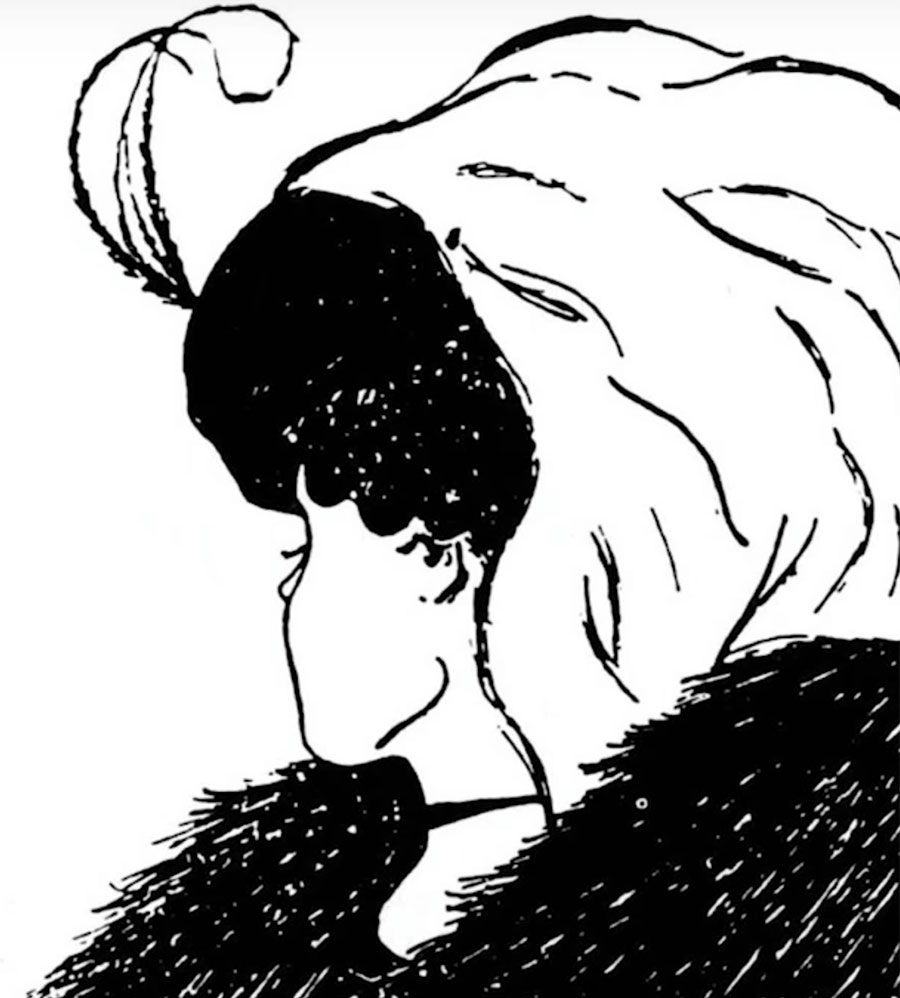Interpretation
For several years my service work with CFSC has involved researching conflicts of all types, as well as various peacebuilding skills and techniques. In 2020 associate member Trevor Chandler and I began facilitating online workshops to help people practice some of these techniques. Over 100 people have taken part so far. In these many conversations, and in the research I’ve done, I’ve seen certain patterns emerge. One that’s particularly important is the powerful role that interpretation plays.
Imagine this: you’re on a dating game show and there are three singles behind a curtain. You can ask the three anything you want to know, but so that their voices don’t sway your decision, they text their answers to the show’s host, who reads them out. Who would you pick to go out with?
The show Mind Field tried this1 but, unbeknownst to the female contestants, the game show was fake and bachelor number two wasn’t human, it was just an artificial intelligence (AI), a sophisticated computer program!
The AI’s answers were often absurd. To the question “What would you cook me for dinner?” it replied, “Roasted bagels.” To “Describe your clothing style,” it responded, “They are made of cloth and have colors.”
But because the women were lacking information—they didn’t know they were talking to an AI—they read into the answers and constructed a whole story about a complex personality on the other side of the curtain.
One of the women called bachelor two, “a little sassy” and two of them said he was similar to their ex- boyfriends. Although the AI’s answers were only barely coherent, the women variously described him as: playful, mysterious, a little into himself, a man-child, and hilarious.
Amazingly, two of the four women chose to go on a date with the AI over either of the human bachelors. What this illustrates clearly is that much of what we believe about a person (or even a non-person) depends not on them, but on us.
You can try this at home. Find a picture of two or more people doing anything whatsoever. Now try to write several different interpretations of what’s happening. Make some generous, and some critical.
I’ll illustrate. Imagine you happen to walk up and see me (a white man) taking this picture.

You might interpret this scene many ways:
- A photo of an Asian person being taken by a white person.
- The continued control of Asian bodies by whites: an expression of colonialism and violence.
- A tokenistic attempt by a white photographer to appear to care about diversity.
- The celebration of an Asian subject: an inclusive centering of Asian people who have too long been under-represented and marginalized.
- Documenting the disgusting and unnatural practice of dying one’s hair.
- A photo taken of a person with a mask on.
- A man being predatory and sexualizing a woman: an example of patriarchy and rape culture.
- Standard behavior of someone socialized into the professional class.
- An artist freely capturing a moment in time.
- A grown man wasting his time with an expensive toy.
- Some fruit, a street, several buildings, a sidewalk, some people, some cars…
- A man sublimating his unconscious murderous impulses into the use of a camera (a symbolic gun).
- A vast quantity of atoms moving in particular ways.
We could go on and on with these. Some may sound more plausible than others, but most are actually surprisingly difficult to verify or falsify.
Whatever interpretation you state, if I disagree, how will we know who’s correct? I could theoretically have any subconscious motivation whatsoever, so I don’t necessarily know what my true motivations are, but then neither do you.
That makes many of these interpretations fertile ground for bitter conflicts, in particular because this simple scene involves sensitive issues like race, identity, and individual freedoms.
Any interpretation we settle on may help us to have new insights into the scene, but it will also limit and filter our understandings.
“Much of what we believe about a person depends not on them, but on us.”
The last interpretation may be technically correct, but it takes the scene to such a complicated level of detail that it’s impossible to understand. Since we’re not super-computers, people can’t deal with describing what happened at the atomic level. We have to round off some of the complexity, to zoom out and pick some elements to highlight and some to ignore.
But each of us will have different preferences about how far to zoom. You may consider the scene in terms of events that happened centuries ago and their impacts up to the present day, while I’m just thinking about what shutter speed to use on my camera.
Maybe you read over my list and shook your head at some: “That’s absurd!” Maybe you read one and thought, “That’s obviously true.”
In either case it’s helpful to know that there are people who are just as thoughtful as you are who make different interpretations. Any time you find yourself laughing off someone else’s beliefs as ridiculous, chances are high that you simply haven’t figured out the reasons behind their thinking, behind what they like to focus on and to ignore.
Importantly, our preferred interpretation of this or any scene will never be totally independent. We want to interpret the scene is ways that we imagine will keep us in good standing with whatever groups we belong to (which provide us care, safety, and social status). This means a whole culture—a whole network of other peoples’ previous assumptions and ideas—props up the interpretation we settle on.
And these cultures are ever-shifting. For example, one review found that interpretations of events as harmful have expanded over time. So today, for better or worse, far less severe instances, and a wider range of events, get interpreted as abuse.2
Thanks in part to the internet, it’s easy to find thorough-seeming arguments for any interpretation whatsoever. Of course not all of these will be factually correct, but the ready availability of well-argued incorrect positions explains part of what’s going on with many bitter societal conflicts. It’s not all bad though. Different interpretations can also give us cause for humility, encouraging some healthy questioning of our own certainties.
The truth is, much of the time we just don’t know which interpretation is correct, and it’s useful (although uncomfortable) to admit it. In particular when we have very little information to go on, like the single event here (knowing nothing about what my conscious intentions are, what I plan to do with the picture, if I take lots of pictures like this with different people in them or if I have a pattern of only taking pictures of people who wear glasses, or people grocery shopping, or women…), it’s very easy to make an interpretation that is both not that useful in understanding the situation, and impervious to correction.
Any attempt I make to counter your interpretation might even be rejected as further evidence of my defensiveness and bias. That’s what’s called a Kafka trap, where a claim of innocence is held up as more proof of guilt.
You say, “Cameras and guns are both pointed at targets, so it’s obvious you were expressing an unconscious murderous tendency.”
I reply, “I didn’t want to kill her though.”
You counter, “Of course you would deny that you wanted to kill her. That’s exactly what happens when you force your murderous desires into your unconscious!”
To address destructive conflicts and build understanding, it helps tremendously if we can define our theory about what’s happening specifically enough that we can have a conversation about exactly what we mean and do not mean.
What would be better still is if we’re so precise that we can test our theory and try to prove it false, not just look for ways to seem to support it (again, we can readily go online and find evidence that seems to support anything we want to believe, so this isn’t helpful), or only interact with those who agree with us.
For a real world example of the problems I’ve discussed here, consider a short open letter published in Harper’s.3 The letter was interpreted as everything from “a simple statement… the kind of thing people say to each other in their sleep”4 to being full of hateful “dog whistles.”5
Building understanding across divides isn’t easy, but it can be done. If you’re interested in practicing, join Trevor and me for the next round of free online workshops.
Matthew Legge is CFSC’s Peace Program Coordinator. Find out more about the Are We Done Fighting? workshop series and register at https://quakerservice.ca/register
- Mind Field, “Artificial Intelligence,” February 1, 2017, https://youtu.be/qZXpgf8N6hs ↵
- Nick Haslam, “Concept Creep: Psychology’s Expanding Concepts of Harm and Pathology,” Psychological Inquiry 27(1), 2016. ↵
- For a blog post I wrote about the letter, with links to it and to a counter-letter, see: Matthew Legge, “‘Cancel Culture’ Letter: 7 Tips from the Debate,” Psychology Today, July 9, 2020, https://bit.ly/391DHEP ↵
- Noam Chomsky quoted in Isaac Chotiner, “Noam Chomsky Believes Trump Is ‘the Worst Criminal in Human History’,” The New Yorker, October 30, 2020, https://bit.ly/35V9PrF ↵
- Emily VanDerWerff, Twitter, July 7, 2020 https://twitter.com/ emilyvdw/status/1280580388495097856 ↵
